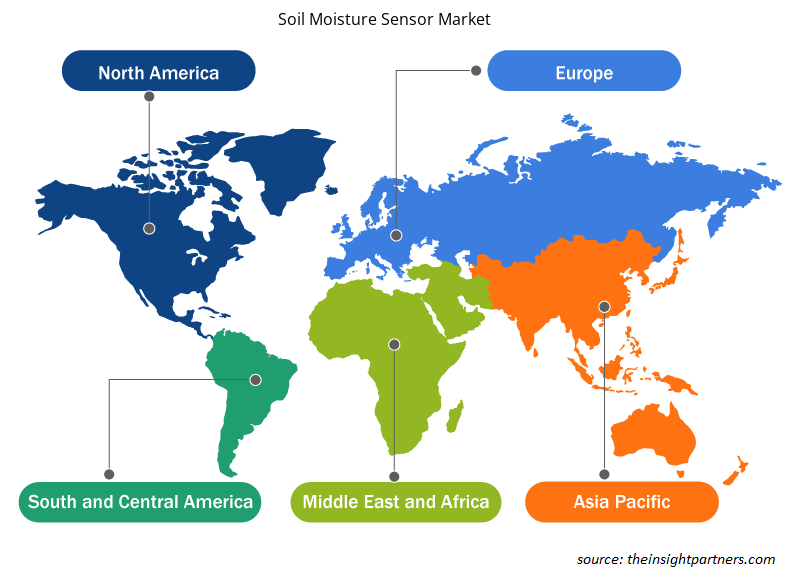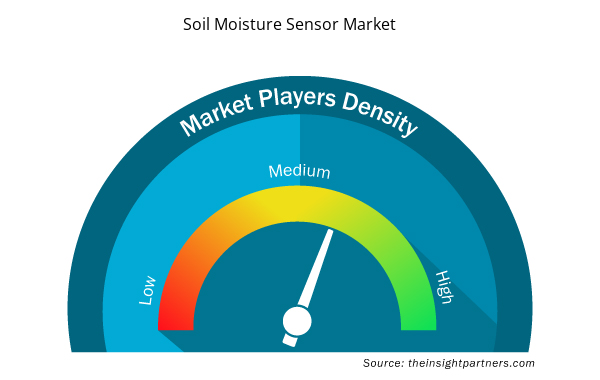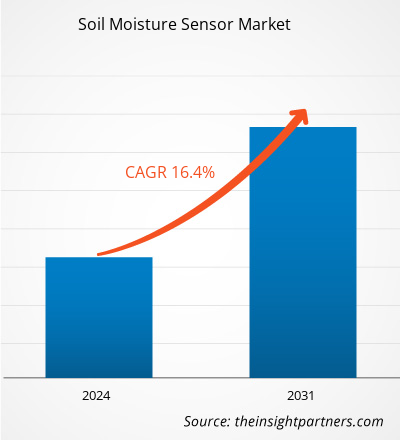土壌水分センサーの市場規模は、2023 年の 2,754.5 億米ドルから 2031 年には 8 億 3,147 万米ドルに達すると予測されています。市場は 2023 年から 2031 年にかけて 16.4 % の CAGR を記録すると予想されています。土壌水分センサーの市場は、人口増加、耕作地の不足、食料価格の上昇、農業技術の進歩などの要因に大きく影響されます。
土壌水分センサー市場分析
農家は、持続可能な方法で資源を管理することの重要性を理解しています。環境と農業はどちらも土壌の質に大きく依存しています。農業において土壌の水分含有量を測定することで、作物生産の実現可能性と収益性を評価できます。その結果、世界中で土壌水分センサーの需要が高まっています。土壌水分センサーは、農業収穫高予測、バイオレメディエーション、埋立地管理、廃水再生、灌漑制御、早期干ばつ警報システムなどで広く使用されています。
土壌水分センサー市場の概要
土壌の水分含有量は、土壌水分センサーを使用して測定されます。土壌水分含有量は、リモート センシングを含むさまざまな実験室および現場技術を使用して測定できますが、土壌水分センサー デバイスを使用するのが最も効率的で迅速な方法です。水道局は、水使用効率化プログラムの実装を通じて、一貫性があり測定可能な節水を達成するという課題に長い間直面してきました。景観を保護するために設計されたプログラムは、伝統的に、灌漑のスケジュール、灌漑システムの維持、および地域環境に適した植物の選択に関する指導に重点を置いてきました。これらの取り組みにより節水が実現したとはいえ、景観灌漑の効率性には、まだ改善の余地が大いにあります。
要件に合わせてレポートをカスタマイズする
このレポートの一部、国レベルの分析、Excelデータパックなど、あらゆるレポートを無料でカスタマイズできます。また、スタートアップや大学向けのお得なオファーや割引もご利用いただけます。
- このレポートの主要な市場動向を入手してください。この無料サンプルには、市場動向から見積もりや予測に至るまでのデータ分析が含まれます。
土壌水分センサー市場の推進要因と機会
スマート灌漑技術の採用増加が市場を有利にする
現在、世界中の国々が直面している主な問題の 1 つは、水不足です。地球上の淡水資源の約 60% は、農業用灌漑用水の主な使用者である農業によって消費されていると考えられています。そのため、農業で使用される水の量を効果的に制御するシステムが必要です。ここでは、より効果的な灌漑戦略を適用して水の消費量を減らし、農業の収穫量を増やすスマート灌漑システムが不可欠です。土壌水分センサーは、作物がいつ、どこで、どのくらいの水を必要とするかを把握するのに役立ちます。この情報は、農家がより多くの作物を生産するのに役立ちます。これらのセンサーの設置は簡単で、.
発展途上国における潜在的な機会。
食糧安全保障は、環境悪化が深刻な脅威となっている発展途上国では特に重要です。中国、インド、ブラジルなどの発展途上国では、農業が主な収入源の 1 つです。急速に増加する人口に食糧生産の需要を合わせるために、これらの国では利用可能な土地を有効に活用する必要があります。土壌水分含有量は作物の生産量を決定する上で重要であるため、これらの発展途上国では土壌水分センサーの必要性が高まることが予想されます。
土壌水分センサー市場レポートのセグメンテーション分析
土壌水分センサー市場分析の導出に貢献した主要なセグメントは、タイプとエンドユーザーの垂直です。
- タイプに基づいて、土壌水分センサー市場は、体積土壌水分センサーと土壌水分ポテンシャルセンサーに分けられます。
- エンドユーザーの垂直別に見ると、市場はスポーツ用芝生、農業、造園およびグラウンドケア、林業、その他に分類されます。
土壌水分センサー市場シェアの地域別分析
土壌水分センサー市場レポートの地理的範囲は、主に北米、アジア太平洋、ヨーロッパ、中東およびアフリカ、南米/中南米の5つの地域に分かれています。北米は土壌水分センサー市場を支配してきました。北米地域のさまざまな業界でのハイテク採用の傾向は、土壌水分センサー市場の成長を後押ししています。デジタルツールの採用の増加や政府機関による高い技術支出などの要因が、北米の土壌水分センサー市場の成長を牽引すると予想されています。さらに、米国とカナダの先進国では研究開発に重点が置かれているため、北米のプレーヤーは技術的に高度なソリューションを市場に投入せざるを得ません。さらに、米国には土壌水分センサー市場のプレーヤーが多数存在し、革新的なソリューションの開発にますます重点を置いています。これらすべての要因が、この地域の土壌水分センサー市場の成長に貢献しています。
土壌水分センサー市場の地域別分析
予測期間を通じて土壌水分センサー市場に影響を与える地域的な傾向と要因は、Insight Partners のアナリストによって徹底的に説明されています。このセクションでは、北米、ヨーロッパ、アジア太平洋、中東、アフリカ、南米、中米にわたる土壌水分センサー市場のセグメントと地理についても説明します。

- 土壌水分センサー市場の地域別データを入手
土壌水分センサー市場レポートの範囲
| レポート属性 | 詳細 |
|---|---|
| 2023年の市場規模 | 2,754.5億米ドル |
| 2031年までの市場規模 | 8億3,147万米ドル |
| 世界のCAGR(2023年~2031年) | 16.4 % |
| 履歴データ | 2021-2022 |
| 予測期間 | 2024-2031 |
| 対象セグメント | タイプ別
|
| 対象地域と国 | 北米
|
| 市場リーダーと主要企業プロフィール |
|
市場プレーヤーの密度:ビジネスダイナミクスへの影響を理解する
土壌水分センサー市場は、消費者の嗜好の変化、技術の進歩、製品の利点に対する認識の高まりなどの要因により、エンドユーザーの需要が高まり、急速に成長しています。需要が高まるにつれて、企業は提供を拡大し、消費者のニーズを満たすために革新し、新たなトレンドを活用し、市場の成長をさらに促進しています。
市場プレーヤー密度とは、特定の市場または業界内で活動している企業または会社の分布を指します。これは、特定の市場スペースに、その規模または総市場価値と比較して、どれだけの競合相手 (市場プレーヤー) が存在するかを示します。
土壌水分センサー市場で事業を展開している主要企業は次のとおりです。
- センテックテクノロジーズ
- イロメーターカンパニー株式会社
- デルタTデバイス株式会社
- スティーブンス水モニタリングシステムズ社
- トロ社
- 株式会社アクリマ
免責事項:上記の企業は、特定の順序でランク付けされていません。

- 土壌水分センサー市場のトップキープレーヤーの概要を入手
土壌水分センサー市場のニュースと最近の動向
土壌水分センサー市場は、重要な企業出版物、協会データ、データベースを含む一次調査と二次調査後の定性的および定量的データを収集することによって評価されます。以下は、市場の動向の一覧です。
- 2023 年 1 月、農業農場管理のデジタル ソリューションにおける世界的リーダーの 1 つである CropX Technologies は、カリフォルニアに拠点を置く精密灌漑会社である Tule Technologies の買収を発表しました。この買収により、CropX 農業農場管理システムに新しいデータ キャプチャ テクノロジーが導入され、カリフォルニアの点滴灌漑特産作物の市場が拡大します。
(出典:CropX Technologies、プレスリリース、2023年)
- 2022 年 10 月、Sensoterra は新しいアンテナ設計を採用した新世代のシングル デプス センサーを発売しました。新しく発売されたセンサーは、LoRaWAN 信号強度を 2 ~ 4 倍向上させ、精度の向上とともに耐久性も向上しています。
(出典:Sensoterra、プレスリリース、2022年)
土壌水分センサー市場レポートの対象範囲と成果物
「土壌水分センサー市場の規模と予測(2021〜2031年)」レポートでは、以下の分野をカバーする市場の詳細な分析を提供しています。
- 対象範囲に含まれるすべての主要市場セグメントの世界、地域、国レベルでの市場規模と予測
- 市場の動向(推進要因、制約、主要な機会など)
- 今後の主な動向
- 詳細なPEST/ポーターの5つの力とSWOT分析
- 主要な市場動向、主要プレーヤー、規制、最近の市場動向を網羅した世界および地域の市場分析
- 市場集中、ヒートマップ分析、主要プレーヤー、最近の動向を網羅した業界の状況と競争分析
- 詳細な企業プロフィール
- 過去2年間の分析、基準年、CAGRによる予測(7年間)
- PEST分析とSWOT分析
- 市場規模価値/数量 - 世界、地域、国
- 業界と競争環境
- Excel データセット



Report Coverage
Revenue forecast, Company Analysis, Industry landscape, Growth factors, and Trends

Segment Covered
This text is related
to segments covered.

Regional Scope
North America, Europe, Asia Pacific, Middle East & Africa, South & Central America

Country Scope
This text is related
to country scope.
よくある質問
The global soil moisture sensor market was estimated to be US$ 275.45 million in 2023 and is expected to grow at a CAGR of 16.4% during the forecast period 2024 - 2031.
The increase in the adoption of smart irrigation techniques is the major factors that propel the global soil moisture sensor market growth.
Opportunities in developing economies are impacting the soil moisture sensor, which is anticipated to play a significant role in the global soil moisture sensor market in the coming years.
The key players holding majority shares in the global soil moisture sensor market are Sentek Technologies; Irrometer Company, Inc.; Delta-T Devices Ltd; and Stevens Water Monitoring Systems Inc.; The Toro Company; Acclima, Inc.; Decagon Devices, Inc.; Campbell Scientific, Inc.; IMKO Micromodultechnik GmbH; Spiio, Inc.
The global soil moisture sensor market is expected to reach US$ 831.47 million by 2031
Trends and growth analysis reports related to Electronics and Semiconductor : READ MORE..
The Insight Partners performs research in 4 major stages: Data Collection & Secondary Research, Primary Research, Data Analysis and Data Triangulation & Final Review.
- Data Collection and Secondary Research:
As a market research and consulting firm operating from a decade, we have published and advised several client across the globe. First step for any study will start with an assessment of currently available data and insights from existing reports. Further, historical and current market information is collected from Investor Presentations, Annual Reports, SEC Filings, etc., and other information related to company’s performance and market positioning are gathered from Paid Databases (Factiva, Hoovers, and Reuters) and various other publications available in public domain.
Several associations trade associates, technical forums, institutes, societies and organization are accessed to gain technical as well as market related insights through their publications such as research papers, blogs and press releases related to the studies are referred to get cues about the market. Further, white papers, journals, magazines, and other news articles published in last 3 years are scrutinized and analyzed to understand the current market trends.
- Primary Research:
The primarily interview analysis comprise of data obtained from industry participants interview and answers to survey questions gathered by in-house primary team.
For primary research, interviews are conducted with industry experts/CEOs/Marketing Managers/VPs/Subject Matter Experts from both demand and supply side to get a 360-degree view of the market. The primary team conducts several interviews based on the complexity of the markets to understand the various market trends and dynamics which makes research more credible and precise.
A typical research interview fulfils the following functions:
- Provides first-hand information on the market size, market trends, growth trends, competitive landscape, and outlook
- Validates and strengthens in-house secondary research findings
- Develops the analysis team’s expertise and market understanding
Primary research involves email interactions and telephone interviews for each market, category, segment, and sub-segment across geographies. The participants who typically take part in such a process include, but are not limited to:
- Industry participants: VPs, business development managers, market intelligence managers and national sales managers
- Outside experts: Valuation experts, research analysts and key opinion leaders specializing in the electronics and semiconductor industry.
Below is the breakup of our primary respondents by company, designation, and region:

Once we receive the confirmation from primary research sources or primary respondents, we finalize the base year market estimation and forecast the data as per the macroeconomic and microeconomic factors assessed during data collection.
- Data Analysis:
Once data is validated through both secondary as well as primary respondents, we finalize the market estimations by hypothesis formulation and factor analysis at regional and country level.
- Macro-Economic Factor Analysis:
We analyse macroeconomic indicators such the gross domestic product (GDP), increase in the demand for goods and services across industries, technological advancement, regional economic growth, governmental policies, the influence of COVID-19, PEST analysis, and other aspects. This analysis aids in setting benchmarks for various nations/regions and approximating market splits. Additionally, the general trend of the aforementioned components aid in determining the market's development possibilities.
- Country Level Data:
Various factors that are especially aligned to the country are taken into account to determine the market size for a certain area and country, including the presence of vendors, such as headquarters and offices, the country's GDP, demand patterns, and industry growth. To comprehend the market dynamics for the nation, a number of growth variables, inhibitors, application areas, and current market trends are researched. The aforementioned elements aid in determining the country's overall market's growth potential.
- Company Profile:
The “Table of Contents” is formulated by listing and analyzing more than 25 - 30 companies operating in the market ecosystem across geographies. However, we profile only 10 companies as a standard practice in our syndicate reports. These 10 companies comprise leading, emerging, and regional players. Nonetheless, our analysis is not restricted to the 10 listed companies, we also analyze other companies present in the market to develop a holistic view and understand the prevailing trends. The “Company Profiles” section in the report covers key facts, business description, products & services, financial information, SWOT analysis, and key developments. The financial information presented is extracted from the annual reports and official documents of the publicly listed companies. Upon collecting the information for the sections of respective companies, we verify them via various primary sources and then compile the data in respective company profiles. The company level information helps us in deriving the base number as well as in forecasting the market size.
- Developing Base Number:
Aggregation of sales statistics (2020-2022) and macro-economic factor, and other secondary and primary research insights are utilized to arrive at base number and related market shares for 2022. The data gaps are identified in this step and relevant market data is analyzed, collected from paid primary interviews or databases. On finalizing the base year market size, forecasts are developed on the basis of macro-economic, industry and market growth factors and company level analysis.
- Data Triangulation and Final Review:
The market findings and base year market size calculations are validated from supply as well as demand side. Demand side validations are based on macro-economic factor analysis and benchmarks for respective regions and countries. In case of supply side validations, revenues of major companies are estimated (in case not available) based on industry benchmark, approximate number of employees, product portfolio, and primary interviews revenues are gathered. Further revenue from target product/service segment is assessed to avoid overshooting of market statistics. In case of heavy deviations between supply and demand side values, all thes steps are repeated to achieve synchronization.
We follow an iterative model, wherein we share our research findings with Subject Matter Experts (SME’s) and Key Opinion Leaders (KOLs) until consensus view of the market is not formulated – this model negates any drastic deviation in the opinions of experts. Only validated and universally acceptable research findings are quoted in our reports.
We have important check points that we use to validate our research findings – which we call – data triangulation, where we validate the information, we generate from secondary sources with primary interviews and then we re-validate with our internal data bases and Subject matter experts. This comprehensive model enables us to deliver high quality, reliable data in shortest possible time.


 このレポートの無料サンプルを入手する
このレポートの無料サンプルを入手する